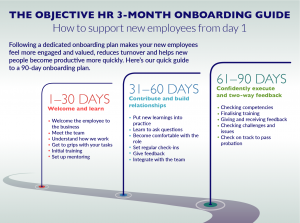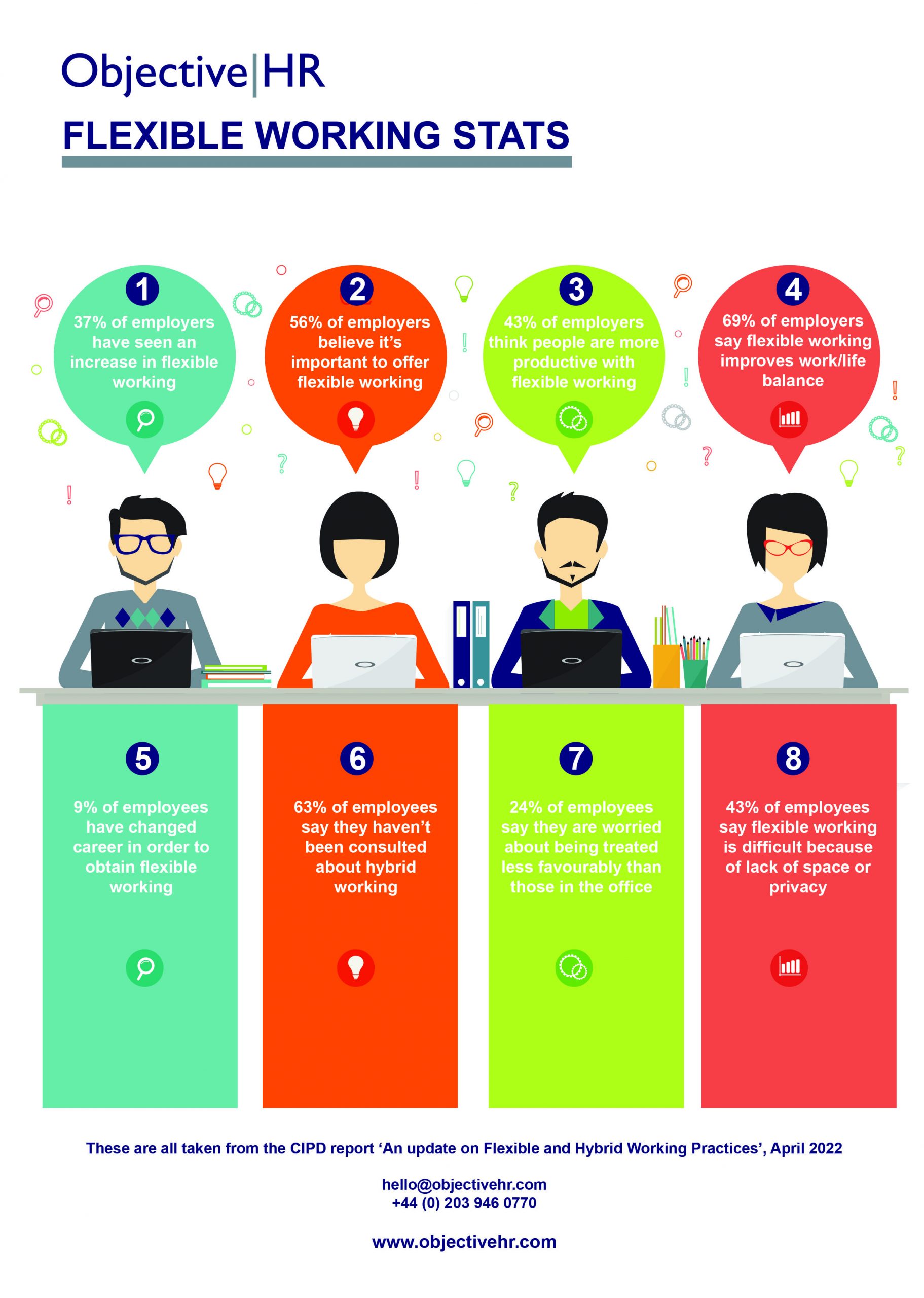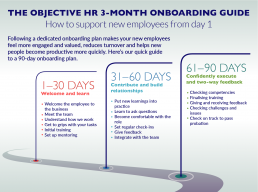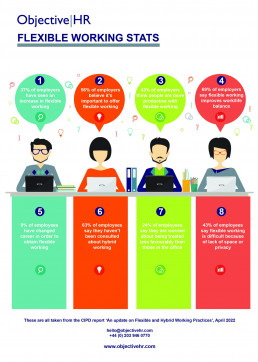The Objective HR 3-month onboarding guide
What does ‘onboarding’ mean to your business? For some, it’s about the first day – the first week at most. And then your new employee is expected to be up and running with the minimum amount of support.
But that’s not onboarding. That’s just bringing someone in and telling them to get on with it. Best practice onboarding is about spending time integrating new employees into the culture, processes and working practices of your organisation, giving them the time and support they need to get up to speed and work productively.
Why does it matter?
It’s a good question. And it’s easy to answer. Companies that have a good quality onboarding process tend to find that they:
- Improve retention
- Boost their employer brand
- Achieve greater productivity sooner
- Build a culture of support and open conversation
- Can use feedback to improve their processes
Of all these benefits, the ones that really matter to organisations are often retention and productivity. That’s because getting either of these things wrong costs money. It’s expensive to keep recruiting new people and training them, only to find they leave at, or even before, the end of their probation period.
And of course, you need your people to be productive. So, the more effort you put into designing a process that can help them feel confident and supported in their new role, the quicker you will reach optimum productivity levels.

Our 30-60-90 guide
When we work with clients, we use the 30-60-90 model. This encourages managers and HR professionals to see how a good onboarding process can work through the entire probation period. It allows both parties to feedback, learn and engage with each other, helping to build trust and employer brand loyalty.
Most importantly, it gives both the employer and the employee a simple structure to follow, with check-ins and measurements in place. This makes administering the probation period much easier, and lets the employee see exactly what’s expected of them – and what support they will be getting.
We’ve put our guide into this handy infographic – if you’d like to talk to us about how to implement this, or any other HR policies and culture design into your organisation, just contact us today.
Time to check your right to work process?
We’ve read several reports recently about employers not having a complete right to work process in place. And some of those issues have been reflected in conversations we’ve had since the start of the new year.
What’s the problem?
It seems to be that employers aren’t aware of the right to work guidance and are making assumptions about the documents they can use to check that candidates have the right to work in the UK. What’s more, some employers do not store or manage Right to Work information properly even if they’ve collected it. In October last year, the government updated their guidance from the temporary guidance issued during the Coronavirus pandemic – and many employers were completely unaware of the changes, even as they were about to come into force.

What does this mean?
A right to work check is a legal requirement, allowing the employer to demonstrate that they have proof that a candidate is eligible to work legally in the UK. If you fail to do this, you can be subject to a fine of up to £20,000 for each ineligible employee. You’ll also potentially face a custodial sentence, and your business reputation will take a significant knock.
The government’s guide, An employer’s guide to right to work checks, states: “If you conduct the checks as set out in this guide and the code of practice, you will have a statutory excuse against liability for a civil penalty in the event you are found to have employed someone, who is disqualified from carrying out the work in question, by reason of their immigration status.”
So, if you carry out your right to work checks properly, and in line with government guidance, you would not receive a penalty if that worker is later found to be an illegal worker.
What should I be doing?
You should have a clear, written process to help you conduct right to work checks for every hire. This should include:
- Conducting the checks before your new employee starts working for you
- Showing clearly how you will store any personal information, in line with data protection laws
- Having a timetable for re-checking right to work if the individual has a visa or other documentation that comes to an end during their employment with you
There are three approved ways of organising a right to work check:
- A manual check – you are responsible for obtaining documentation from the lists approved by the government. You must then check that documentation to make sure it is genuine, and you must keep a copy of each document in a way that cannot be manually altered. You should also have a separate record of when the checks were undertaken, and you need to store all the relevant information during the period of employment and up to two years after the employment ends.
- An Identity Service Provider check – you can manage your right to work checks digitally by using the Identity Document Validation Technology. To do this, you’ll need to use an approved supplier – the Identity Service Provider. This option is for valid British or Irish passport holders only, and the candidate must agree to this type of check.
- A Home Office check – if your candidate has a current immigration work status, you can use a Home Office service to check this status online. This may not cover all types of immigration work documents, so you may have to use your manual check process instead.
At Objective HR, we can assist with digital right to work checks - they are quick and cost effective. All we need is your candidate’s mobile number and email address. We’ll send them an SMS message to get things started. There’s no need for them to download an app or login to a portal – they simply take a selfie and a photo of their passport. The check usually comes back within 24 hours and we send you a complete Right to Work report that you can keep for your records.

It's worth bearing in mind that 20% of the UK population do not have a passport and would fall out of this process. There are also occasions where individuals do not want to provide their information digitally and so would fall out of the process – in these cases, we can help you to make sure your manual process is thorough and within the government’s requirements.
What's your thinking on flexible work?
A recent report by CIPD has shone an interesting light on how both employers and employees are feeling about flexible - or hybrid - working. Driven, of course, by the pandemic, this has become a key demand from candidates, and we're finding that companies who are sticking rigidly to office-based working are struggling to recruit.
Of course, there's a balance to be had, and we're working closely with our clients to help them construct flexible working processes that are legal, fair and support good quality recruitment and retention. Below are some of the stats we've found most interesting - if you'd like to talk to us about how to design your own flexible working approach, just contact us today.

Are you ready for in-person Right to Work checks?

Before the COVID-19 pandemic, all employers had to conduct Right to Work checks. These were usually done in person and required the employer to have sight of original documents.
By the point of the first lockdown in March 2020, it was impossible for in-person checks to take place, so the government allowed Right to Work checks to take place digitally. This has meant that employees have used video calls, scanned documents and sometimes checks via mobile apps.
Originally, in-person checks were due to start again in May 2021, but the government has extended this to June 21st – the start date of the final step in the roadmap to lockdown easing.
What does this mean for you?
As an employer, the return to in-person checking means that you must now check the applicant’s original documents. For employees, you must be in possession of all the relevant documents needed to confirm that you have the right to work in the UK. You must give these documents to your employer – they will be returned to you – so that they can carry out the appropriate checks.
What are the checks?
Employers have a responsibility to check that:
- The documents are genuine, original and unchanged and belong to the applicant
- The dates for the individual’s right to work in the UK have not expired
- Photos are the same across all documents and you are sure they look like the candidate
- Dates and places of birth are the same across all documents
- The candidate has permission to do the type of job they have applied for, including any limit on the number of hours they can work
- For students, you should ask for evidence of their study and holiday times
- If documents give different names, you should ask for supporting documents, such as a marriage certificate or divorce decree to prove a change of name
Make sure you know what’s needed
There’s a clear guide on the government’s website – the Right to work checks: an employer’s guide. This sets out what’s required in terms of checks for applicants from a range of different areas, including EU, non-EU, EEA and non-EEA applicants. It’s worth checking the guide so that you know exactly what you need to do depending on the candidate.
If you need any support on reintroducing in-person Right to Work checks to your organisation, contact us today.
Onboarding: How are you changing?

If there’s one thing we know about working during a pandemic, it’s how tricky it is to bring new people into the business when we are working remotely.
In pre-COVID times, of course, we would have had a well-thought-out induction process. This would give a new starter not just the legal information they needed, but a chance to meet their team properly, sit in on meetings and discussions and get to know the business and how it works. There would be tours or walkabouts, a desk to get set up, and much more.
Today’s new starter is likely to have a laptop and phone couriered to their door, a Zoom meeting and not much more.
But that will need to change, because our ways of working are changing. Anecdotal evidence suggests that whilst businesses are starting to return to the office, they are also looking at hybrid working, where people use a mixture of office and remote working.
Businesses should also note that ‘remote’ does not equate to ‘home’. Many people want to reduce their commuting hours so would rather work closer to home for a few days each week. For some, that might mean a home office, but others may use co-working facilities, so it’s important to know what sort of facilities your people are working from, so that you can support them accordingly.
Why change your onboarding process?
A good onboarding process can be the difference between your new employee integrating really well into your business, and deciding to leave pretty quickly. You need to make them feel welcome, be clear about their role and responsibilities, and help them to communicate with their line manager and team members. But that’s just the start. Onboarding doesn’t finish after two hours of induction – in order to onboard well, you need to make sure your new starters are supported on an ongoing and regular basis.
Here are some of our key thoughts about updating your onboarding process for today’s workplace:
- Assign a buddy – we’ve seen this work really well in client businesses. A buddy can be on the new starter’s team, or part of a general ‘buddy’ group. Their job is to check in regularly, answer common questions, help to integrate the new starter into the business and give them somewhere to turn to with questions.
- Give line managers clear guidance – whilst initial onboarding is often carried out by the HR team, the ongoing work needs to be done by the new starter’s line manager. So that line manager needs to be engaged with the process, understand its purpose and importance and commit to keeping in touch and making sure the new starter can get to work productively and comfortably.
- Use technology to your advantage – you can use aids like DocuSign to allow new starters to sign contracts, staff handbooks and other paperwork remotely, and you can also use technology to help integrate people into the business. If everyone is still working remotely, why not hold an informal half hour lunch meeting, where people can have a chat over food? Or introduce a coffee break to allow people to have those all-important ‘water cooler’ conversations? Technology allows you to introduce informality into the work day without disrupting positivity.
- Bring new starters into the office – if they are comfortable doing so, arrange for new people to spend a day or half a day in the office. They will get a feel for your workspace – and for the journey – and can get used to the way things work without the office being full of people. If you’re bringing people back into the office on a rota basis, make sure your new starter is in at the same time as members of their team, so that they can meet face-to-face.
Onboarding obviously varies from one company to another. The thing to remember is that you can’t just shoehorn your existing process into a new form. You need to think it through and plan it carefully so that it works within the new way your business is working.
We’re guiding and advising clients on improving their onboarding process to help them motivate and retain productive, engaged staff. Talk to us if you’d like help or advice for doing this in your own business.
Q&A: Need help choosing a Kickstart Scheme gateway partner?

The Government’s Kickstart Scheme is underway, and is helping to create thousands of six-month job placements for under the age of 24 and on Universal Credit. The aim of the scheme is to help this age group into permanent employment once they have completed their placements.
Q: Who can take advantage of the scheme?
A: Any business or organisation can take on a young person under the Kickstart Scheme. You can be in the private, public or voluntary sector. When you take on someone under the Scheme, you’ll get a payment of £1,500 – per placement – to help you support the process. The Government says that: “Funding available for each job will cover the relevant National Minimum Wage rate for 25 hours a week, plus the associated National Insurance contributions, and employer minimum automatic enrolment contributions.”
Q: How does it work?
A: You can apply to the government direct if you want to take part in the scheme. Until recently, only companies who could offer more than 30 placements could do this, but the rules have recently changed to allow any employer to apply. You may choose to use a Gateway Partner, however. This is someone who can manage the process for you.
Q: What’s the benefit of using a Gateway Partner?
A Gateway Partner already has experience and expertise in using the scheme. In our case, we are able to support clients with a development plan for the placement including help and support with their CV and interview skills, and joining our online development sessions in a range of topics around personal development skills (prioritising, effective communication, presentation, etc). We work closely with the organisation during the placement and if there is not a role at the end, we would support the individual in gaining employment and give them some 1-1 advice and support.
Q: How do I work with Objective HR as a Gateway Partner?
A: We can apply to the government on your behalf. We ‘batch’ applications into groups of 30 or more and submit them directly to the Department of Work and Pensions (DWP).
We’ll give you all the help and advice you need to decide how many placements you can offer, and to complete your initial application. We can also help you to set up a plan for onboarding, training and developing your placement person so that both you and they get the most from the scheme.
We have been approved by the DWP to offer this service, and we can keep on applying for placements as long as the demand is there. We can’t guarantee that you will be approved – there are other checks that the government carries out to make sure you meet the criteria – but we can make sure that you can apply and that your application is as good as possible.
Q: How does the selection process work?
A: Once the placements are agreed and the job spec is complete, we send the details to the DWP and they source and send CVs directly to you. You would then follow your own recruitment process to choose a suitable placement – you will not be forced to take anyone. We can support the interview process if needed, and if your sector is regulated, we can also offer referencing, credit and DBS checks if that is a normal part of the selection process in your sector.
Q: Do I have to be a client to work with Objective HR?
A: Absolutely not – we work with a wide range of organisations to manage Kickstart Scheme applications. There’s no obligation on you to work with us at all in any other way.
Q: Do I have to pay you to be my Gateway Partner?
A: No. We do not charge for the placement service – the government pay us a small fee per placement. If you wanted to take advantage of our in-depth training, we’d be happy to discuss this with you as a separate project.
Q: Why should I choose Objective HR over other Gateway Providers?
A: You might want to work with a trade body or your local authority to apply for a placement. We are HR specialists with lots of experience in placing and developing people. We understand how the process works and we’re used to working closely with employers and communicating well, so that you know exactly what’s happening at every step of the process.
Q: Can you support the development of our placement trainee?
A: Yes, we can. We are specialists in development and training and we can help you put a clear process and programme together that helps your placement person to get real value from your business, and for you to feel they are delivering value to you too.
Q: Can we apply more than once for a placement?
A: Yes, you can. You can create as many positions as you like, as long as it’s a genuine role, not previously advertised and will not replace any existing employee now or in the future. Once any placement trainee’s six month period has finished, you can apply for someone else to take the placement.
Q: Can we offer our placement trainee a permanent position once the initial period is over?
A: Yes, you can. You’re under no obligation to offer them a permanent job, but if you and they feel that there is a good fit, and you have the budget and role available to offer a permanent job, you can.
To find out more about using Objective HR as your Gateway Partner, please contact us today.
Why it’s a serious risk to ignore candidate screening and referencing

Pre-employment screening and referencing should be a key part of your recruitment process. Aside from the fact that you have a legal obligation to make certain checks, screening also ensures that the person you are employing is who they claim to be – with the qualifications, experience and background they claim to have.
As many businesses have discovered to their cost, failing to properly screen and reference candidates can lead to a range of issues – from theft and fraud to violent or unsafe behaviour. And for businesses employing someone who doesn’t have the right to work in the UK, there are both civil and legal consequences that could seriously damage your reputation.
Making screening part of your process
Our advice is to make sure that pre-employment reference and screening is a habitual part of your recruitment process. For many businesses, this process can be explained in a simple flowchart – you can work on this alongside your HR adviser or recruitment agency to make sure it covers all your requirements.
The screening and referencing part of the process may come in at different stages for different businesses. For most businesses, however, these checks take place pre-employment – once the candidate has been selected and the offer made. In these circumstances, the offer is usually ‘conditional’. This means that the business requires successful screening and referencing results, as well as satisfactory personal references, before the offer is made final.
What screening checks are necessary?
The range of checks that you want to include in your process are likely to be tailored to the type of business you run, but there are some that you are legally obliged to do. You have a legal duty to make sure that anyone you employ has the right to work in the UK. It’s important to note that, whatever the circumstances, you can be subject to both civil and criminal penalties if you are found to be employing someone who does not have that right. Civil fines can be up to £20,000. And as far as the criminal legislation is concerned, you can face unlimited fines and a prison term of up to five years if you are found to have knowingly employed someone who doesn’t have the right to work in the UK.
So, at the very least, you should ask prospective employees to supply their original right-to-work documents. You should then take ‘all reasonable steps’ to make sure that the document is genuine, and relates to the individual applying for the job. You also need to check that the document allows that person to work in the type of role they are applying for. Once you are satisfied, you need to copy the document and keep it in a secure format that cannot be altered.
Even for those who have an automatic right to work in the UK, you should check identity via passport or driving licence, and make sure that the candidate has the qualifications and work experience they claim. Sadly, it’s not unusual for people to lie on their CV – and this may be even more prevalent at a time where many people are applying for job roles.
Checks for specific sectors
Workers in some sectors need to go through particular screening and referencing checks to make sure that they meet regulatory requirements. These might include the medical, insurance, banking and financial services sectors, where the regulator requires specific checks on criminal background and industry-relevant qualifications or registrations.
If your business operates in a regulated sector, your business and reputation is at significant risk if you employ someone who doesn’t meet the relevant criteria. That’s why it’s important that you are up to date with the latest requirements and invest in reliable screening services that meet your regulator’s requirements.
Getting ahead of the game
It can be daunting to run screening and referencing checks yourself – particularly if you don’t have an in-house HR function. And yet you are still required to check out all the candidates you make job offers to.
So it makes sense to get ahead of the game by outsourcing the screening and referencing part of your process to a trusted partner. This can be a specialist consultancy like Objective HR, which has all the legislative insight and access to the latest screening tools.
All our checks are carried out to recognised standards, including BS7858, and we manage sector-specific checks such as FCA, SMCR, PCI-DSS, Airside and the Care Quality Commission. In addition, we can run identity, qualification, criminal, DBS and employment history checks, giving you a thorough and individual report on each candidate.
To find out more, take a look at our dedicated screening and referencing service, or contact us today.
Our guide to better interviews

Whatever side of the desk you’re on, you can probably up your game for your next interview. For employers, it’s important to take the time to find the right candidate, so that you spend your recruitment budget wisely and build a strong team. For candidates, the right approach to interview can significantly enhance your chances of getting an offer – even if you don’t meet all the criteria on paper.
With years of expertise in finding candidates and interviewing on behalf of clients, we’ve been able to compile a list of advice and tips that can help anyone involved in an interview to work towards the best outcome. Of course, we can’t guarantee that you’ll get the job, or make the best hire, but we can absolutely share some tips that will help to point you in the right direction.
These tips apply just as much to the new way of interviewing – via Zoom or Teams or other online platforms – as they do for traditional face-to-face interviews. Body language, tone of voice and interaction remain just as important. So you can apply this advice straight away, no matter who you’re interviewing, how or when.
For interviewers
Be aware of bias – unconscious bias is all about the decisions you take and opinions you form without even realising it. Understanding your own potential biases and working hard to overcome them is no easy task, but it’s vital for conducting a better interview. We’d take exception to being told we are biased about some things, but the fact remains that we often are. According to Psychology Today, some of these biases include:
- The perceived physical attractiveness of the candidate
- The perceived things you may feel you have in common with the candidate
- The stereotypes you may hold about gender, age, nationality, ethnicity, qualifications and religion
- The assumptions you may make based on dress, voice and non-verbal signals
In order to overcome bias, and remembering that the way that candidates behave in interview is highly influenced by stress and nerves, you need to have a clear structure for the interview that is consistent across all the candidates you see. This means you will have a standardised basis for looking back at the interviews to make a decision. In theory, it should also mean that you can hand your notes to someone who wasn’t in the interview and they should be able to see who is the best candidate.
Our top tips
- Really prepare for the interview. Know exactly what you are looking for in the right candidate, in terms of qualifications, experience, attitude and willingness to develop. Read the candidate’s CV thoroughly, along with any other material they have been asked to submit. Look for particular areas that may need further investigation or that you think are particularly relevant to the role.
- Set a standard list of questions. You need to be able to compare candidates after the interview process and this will be easier if you ask them the same things. You can go off-topic to explore answers, but you should to your list to make sure you are gathering all the most relevant information. Finally, keep your questions open, so that you give the candidate a chance to explain or expand, rather than just giving ‘yes’ or ‘no’ answers.
- Listen to your candidate. The most common problem with interviewers is a failure to listen. Instead, you’re focused on getting through the questions on your list and, in your mind, you’ve already decided what ‘golden’ responses you are looking for. We can pretty much guarantee that if you don’t listen and concentrate on the answers your candidates give, you’ll end up hiring the wrong person. As a leader, you should be able to listen to an answer and see how it reveals something that might be useful or flags up a warning sign.
- Set expectations – tell the candidate at the start how long you expect the interview to last and what you will be covering. If you are introducing other elements into the interview, such as the opportunity to meet other members of the team, a presentation, a test or a group challenge, you should let them know. Obviously, for some interviews, you will have spoken to the candidate ahead of time if there’s anything you expect them to prepare in advance.
- Stay on the right side of the law – there are questions that you are not allowed to ask in interviews because they are discriminatory. Stick to the attributes, qualifications and experience for the role.
For candidates
At a time when redundancies are being announced on an almost daily basis and there are hundreds of applicants for a single job role, it’s a real achievement to get to the interview stage of the process. And that’s often when the nerves kick in. At the moment, most interviews are happening via video call, which might mean that you can do them from the comfort of your own home, but also means that you’re at the mercy of the technology and that there are some new things to think about.
You may have already gone through a phone or video interview with a recruitment consultant – we speak to all of the candidates we shortlist to make sure that they are a good fit for the role and for the company. So that means you should have picked up quite a lot of background about both the company and the job you’ve applied for.
Our top tips
- Check your technology. If you’re interviewing online, try to use a tablet or laptop rather than your phone. Make sure you have checked that you have strong enough wifi, and if you don’t perhaps arrange to go to a friend or relative’s house where you can use stronger wifi. If you’re doing this, make sure it’s within the regulations and that you socially distance.
- Make an effort. Just because you’re interviewing online, you can’t assume that everything’s more relaxed. You still need to project a professional image, and that includes making sure you have a neutral background and good lighting so that there’s nothing to distract the interviewer from what you’re saying.
- Be prepared. Make sure you’ve checked out the company as thoroughly as you can. Look at the website, read their news pages, check out their product or service development. Follow them on social media and find out what’s important to them. Get used to their tone. You can look your interviewer up on LinkedIn now – there’s no excuse for being unprepared. By the same token, make sure you’re really confident about the role and what the company is looking for.
- Have your CV and any other documents ready to share. The beauty of an online interview is that you can share your screen to talk your interviewer through elements of your CV, or to showcase other work that you’ve done. If you’ve been asked to prepare a presentation, make sure it’s open on your screen and ready to go when it’s needed.
- Be engaged – look directly at the camera, if you’re interviewing online, or make regular eye-contact with your interviewer if it’s a face-to-face meeting. Be enthusiastic – but not over-the-top and engage positively with the questions. This is your chance to show how you can add to the business. We know that not everyone is outgoing, but if you are quieter or more introverted, you can still demonstrate passion and enthusiasm for the things that matter to you.
- Have some questions. This is standard interview advice, and that’s because it’s really important. Move away from basic questions about holiday or pay, and find at least three interesting questions to ask. These might be about learning and development programmes, or their attitude to sustainability, or their diversity programme. Ask questions that will help you to find out if this is a company you really want to work for.
- Make sure you know the next steps. You’ll want to know how soon you’ll find out about the decision and what feedback you might get. Be as relaxed as possible at the end of the interview – don’t bolt out of the door or leave the video meeting too quickly.
Whatever the role and whatever the circumstances, the interview is a critical part of the recruitment process for both sides. Approaching it with structure, preparedness and confidence can help everyone get the most from an interview, and can help both the interviewer and the interviewee learn valuable lessons for next time.
Find out more about our recruitment support here or contact us to see how we can help.
Recruiting? You might get more than you bargained for
Recent months have seen thousands of people being made redundant. Despite all the schemes put in place to help businesses and individuals, some companies simply haven’t been able to maintain operation at the same level as the start of the year, and that means there are a lot of people chasing the available jobs.
This point was made fairly starkly recently when a hotel reported that it had received more than 1,000 applications for a receptionist role. It had only expected 30. Dealing with the volume of applications is one thing: weeding out the people who actually have the skills or experience to do the job is quite another.
A recent survey by the Recruitment and Employment Confederation found that those employers who are looking for new staff are becoming more confident about starting to hire as their businesses start to return to work after the lockdown. Of course, some businesses have been extremely busy and needed to hire during lockdown, whilst others have been biding their time and waiting to see what a post-lockdown business world looks like. But the fact that businesses are now actively hiring at the same time as growing numbers of people are looking for work means that employers could suddenly see a significant rise in applications.
How to manage job applications
The easiest way to reduce the burden of sifting through hundreds of applications is to work with a recruitment partner. That way, you’ll still see just the most relevant and useful CVs to help you take the next step. It may take longer to get to this point, however, because each application will need to be read and considered.
You could also be clear in your job adverts about exactly what you’re looking for. This may deter people who are applying for ‘anything’ and leave the path clear for the applicants who have the skills or experience you need. This isn’t guaranteed, however: we have been working on recruitment for some very specific roles, only to find that we are getting hundreds of applicants, many of whom have none of the skills or qualifications needed.
Instead, employers may have to accept that, for the moment at least, you will be over-subscribed if you advertise a new post. At the same time, you need to have a policy for how you manage rejections, because poor management could reflect badly on your brand reputation for years to come. More importantly, we’re hearing that people are struggling with low self-esteem around rejection on top of poor mental health because of the challenges of the pandemic, so it remains the employer’s role to handle applications responsibly and with empathy wherever possible








